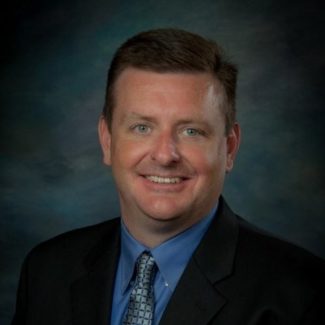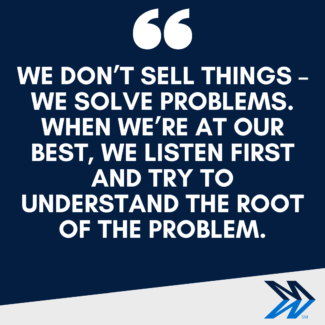January 14, 2021
 A very recent addition to Mindsight’s leadership team, CIO/COO Tad Gralewski re-joined the company in December 2020. Tad was instrumental in refining and driving tremendous growth in Mindsight’s managed services business in the 2013 through 2016 timeframe, but left Mindsight to pursue other opportunities. We’re excited to have him re-join the Mindsight team in his expanded role. With a wealth of IT experience that spans nearly three decades, Tad has the skills and ambition to make Mindsight even more competitive and effective in 2021 and beyond. Here’s some insight into who he is and what drives him – inside and outside of work.
A very recent addition to Mindsight’s leadership team, CIO/COO Tad Gralewski re-joined the company in December 2020. Tad was instrumental in refining and driving tremendous growth in Mindsight’s managed services business in the 2013 through 2016 timeframe, but left Mindsight to pursue other opportunities. We’re excited to have him re-join the Mindsight team in his expanded role. With a wealth of IT experience that spans nearly three decades, Tad has the skills and ambition to make Mindsight even more competitive and effective in 2021 and beyond. Here’s some insight into who he is and what drives him – inside and outside of work.
How would you describe your current role at Mindsight to someone outside the industry?
I am in a unique position, because I’m responsible for both delivering Mindsight’s services to our customers and working with them to help develop strategies, roadmaps, and solutions to solve their issues. I rely on my past experience in executive IT leadership roles to help drive improvement in our delivery processes and teams. Ideally, that experience and know-how also enhances the sales process for our customers.
How would you describe Mindsight and the value the company delivers to clients?
I think it directly relates to our tagline of technology, transparency, and trust. Mindsight is a collaborative team of subject matter experts who have a shared goal of providing indispensable consultative expertise to our customers. We don’t sell things – we solve problems. When we’re at our best, we listen first and try to understand the root of the problem. We don’t lead with technology; we lead with creative solutions based on decades of collective team experience.
 What is going on in the technology world that excites you right now? Any predictions for what trends will emerge in 2021?
What is going on in the technology world that excites you right now? Any predictions for what trends will emerge in 2021?
What isn’t exciting these days? The continued Cloud transition, in whatever way you define Cloud, is all-consuming and continues to evolve. Add in a global pandemic — which has significantly changed how the workforce operates and from where — and I think companies that were more resistant to change over the last few years now understand why Cloud transformation is so important. Besides providing better flexibility, it dramatically improves the user experience and delivers corporate applications to their employees in newer, better, and more agile ways.
Customers can now reach the businesses they patronize over a variety of platforms, 24/7. They can also quickly research competitors. How has “customer experience” changed as a result of these developments?
People want flexibility. Our customers certainly demand it, and that’s what we deliver. The workforce is changing, and work doesn’t take place only from 9 to 5 in an office building. Our customers are effectively working around-the-clock, and so do our engineers.
What’s one professional challenge you’ve faced, and how did you overcome it?
I thrive in fast-paced, agile, innovative environments where people are working together to drive improvements, accomplish goals, make things better — and having fun while they’re doing it. What I don’t easily accept is a That’s the way we have always done it, so why are we changing? mentality. It just doesn’t work for me. Unfortunately, I’ve ended up in environments where that’s the norm, change is lethargic, and leadership is more interested in the status quo than improvement. In general, though, people want to see improvement, they want to make things better, and they want to have fun. But change isn’t possible in every organization. There are those that say they want change, but company culture or leadership can get in the way. I have been able to drive change at many places in my career — but not all. You need to understand when change is not going to happen, and either accept that or move on.
There are many forms of effective leadership. What has worked for you, and how are you still evolving?
Collaboration works. I’m fortunate to be surrounded by a lot of extremely driven and intelligent people from whom I learn every day. Our delivery teams are the eyes and ears of our organization, listening and reacting to the needs of our customers. They understand what’s working and what’s not working. I want to hear what they have to say and help drive more positivity into our work environment, which in turn creates a better experience for our customers. Great ideas come from within. At the same time, an effective leader needs to provide direction and make sure the team has a sense of focus and purpose. At a strategic level, this is the most important thing I can provide. I can help the team understand the why and what: Why are we doing this? Why is it important? What impact are our actions having on our customers’ successes? Getting everyone to adopt and constantly maintain a customer-first mentality is the most important thing to me.

Briefly describe your academic background. Any favorite courses that might be viewed as atypical considering your current line of work?
I attended the University of Illinois and started out in Computer Science, but quickly realized that programming wasn’t something I wanted to do. I wasn’t great at it, and I didn’t find it terribly interesting. My interest in information technology, however, led me to several roles at the university, including working on their help desk and teaching classes to faculty and staff on how to use computers. Remember, this was the early 1990s. Eventually, I ended up working as a network administrator for the College of Commerce. That’s where I cut my teeth, learned networks, servers, how people used them and for what. It’s also when I realized that helping people with technology was what I wanted to do for my career. The human element of information technology was missing for me as a programmer, but it was ever-present working on a help desk or in network support. That’s what I liked and like best about IT — the people. Because of that, I decided to get a degree in speech communications, which taught me how to organize my thoughts, make an argument, and effectively communicate verbally or in writing. Of all things in my career, that’s what has set me apart from others. As I became a more skilled network engineer or data center engineer, I was able to use my communication skills to work more productively with other managers and leaders. Consequently, my career took off — but I never lost sight of why. To this day, I rely on that combination of technical expertise and communication skills to help our customers solve problems.
 Three parts to this one: 1) Are you more or less disposed to risk than you used to be? 2) What’s the biggest professional risk you’ve taken? 3) How do you know if a given reward is worth the risk?
Three parts to this one: 1) Are you more or less disposed to risk than you used to be? 2) What’s the biggest professional risk you’ve taken? 3) How do you know if a given reward is worth the risk?
Risk is relative, and risk is something that requires a larger audience than just one individual. The decisions one person makes regarding risk are only a small part of the overall puzzle. So risk tolerance at the task level hasn’t changed for me over time. I want to understand how we can best protect data, system integrity, network security — these things are critically important and cannot be overlooked. But they’re only part of the story. Understanding the holistic impact of a decision, design, or solution at the task level can be difficult and requires discourse with other individuals to make sure that a tactical decision — which may be the right one, by the way — doesn’t impact the bigger goal. Or, better yet, if it is going to impact the bigger goal, how is this requirement communicated and distributed to everyone involved in the project so that they view the decision as necessary, and not as a blocker? My approach to risk management has evolved as a result, and involves taking a more strategic view of risk mitigation rather than thinking about risk only at the tactical level.
Who was your most important mentor, and what did you learn from them?
There is one individual for whom I have worked multiple times at different companies. This leader has shown me great examples of not just how to align with business goals, but how to do so in an inclusive and collaborative way with a consistent and steady leadership approach. There are always going to be stressful and unexpected situations, and having a common and steady approach to problem solving, whether the problem is strategic or reactive, is critically important for a good leader.
What are some of your favorite ways to escape and recharge?
I’m an outdoors person and I really enjoy adventure vacations – camping, hiking, riding motorcycles. I’ve traveled most of North America on a motorcycle, and I like finding out-of-the way places. They may take time, effort, and desire to get to, but it’s all worth it when I can sit and enjoy the view and silence. I also have two sons, both of whom ride dirt bikes, and we have been fortunate to spend time camping in Michigan, Colorado, Missouri, South Dakota, and other places where we’ve been able to ride all day and enjoy family time outdoors at night. But I do need a break every now and then. A week on a beach with few or no plans, no running around, just listening to the waves and watching my kids build sandcastles while I recharge is never a bad thing, either.
What’s one thing you know now that you wish you’d known at or near the start of your career?
Not everything is black or white, and in technology it’s very easy to fall into this trap. There may be a “best” way to configure something, but if that way doesn’t enable the company to fully take advantage of the solution, then this “best” solution just un-solved the problem that somebody else is trying to solve. As an engineer, it’s difficult early in your career to align and understand how your actions are impacting the business. It’s hard to see how a firewall rule, for example, impacts a sales team, or how a storage policy impacts an executive. Firewall rules are important, and so are cost savings – but not at the expense of enabling the business. From a technical-only standpoint, these things may be the “best” things to do, but what’s the point if it means that business processes now fail? It’s hard for a network or server engineer to understand this at times, as they may not truly understand the goals of the business. That could be an issue related to leadership or experience. Whatever the case, taking anything other than a “technology-only” approach is hard. It requires business acumen, strong leadership above you to help find the gray areas and time to understand them. Once you do, you realize that the ability to understand and embrace gray areas is what separates an engineer from a technologist.
About Mindsight
Mindsight, a Chicago IT services provider, is an extension of your team. Our culture is built on transparency and trust, and our team is made up of extraordinary people – the kinds of people you would hire. We have one of the largest expert-level engineering teams delivering the full spectrum of IT services and solutions, from cloud to infrastructure, collaboration to contact center. Our customers rely on our thought leadership, responsiveness, and dedication to solving their toughest technology challenges.